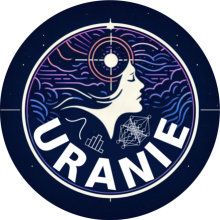Documentation
/ Manuel utilisateur en Python
: 
The objective of this macro is to optimize a function using the Efficient Global Optimization algorithm (EGO). EGO is well suited for problem when solution evaluations are expensive (efficient) and when problem has local minima (global). In our example, evaluations are parallelized with threads to point out the standard context of its use.
The user function is inspired by an academic function, Himmelblau. It is a multimodal function used to point out the global search that is realized. The problem have 5 parameters and 8 optimal solutions.
This macro follows the structure of an reoptimizer macro (see previous chapter) and we take a quick look at generic part. Only specific codes are explained in more details.
import ROOT
from ROOT.URANIE import DataServer as DataServer
from ROOT.URANIE import Relauncher as Relauncher
from ROOT.URANIE import MetaModelOptim as Ego
# user choice
krigingStep = 50
cpus = 6
optimStop = 360
# user optim fonction
def userfun(x1, x2, x3, x4, x5):
ret = 0.
tabx = [x1, x2, x3, x4, x5]
tmp = x1*x1 - x2 - 6
ret += tmp * tmp
for i in range(1, 5):
if i % 2:
tmp = tabx[i]*tabx[i] - tabx[i-1] - 6
else:
tmp = tabx[i] - tabx[i-1]
ret += tmp*tmp
return [ret, ]
# optim procedure
def ego_test():
# variables
inputname = ["x1", "x2", "x3", "x4", "x5"]
inputs = [DataServer.TUniformDistribution(str, -8., 8.) for str in inputname]
output = DataServer.TAttribute("y")
# optim function
fun = Relauncher.TPythonEval(userfun)
for i in inputs:
fun.addInput(i)
fun.addOutput(output)
# runner
run = Relauncher.TThreadedRun(fun, cpus+1)
run.startSlave()
if (run.onMaster()):
tds = DataServer.TDataServer("tds", "ego tds")
for i in inputs:
tds.addAttribute(i)
kmod = Ego.TEgoKBModeler()
kmod.setModel("matern7/2", "const", 1.0e-8)
kmod.setSolver("ML", "Bobyqa", 300, 800)
hjsolver = Ego.TEgoHjDynSolver()
hjsolver.setSize(64, 16)
egosolv = Ego.TEGO(tds, run)
egosolv.setSize(krigingStep, optimStop)
egosolv.setModeler(kmod)
egosolv.setSolver(hjsolver)
egosolv.addObjective(output)
egosolv.solverLoop()
tds.exportData("egoPy.dat")
run.stopSlave()
# run test
ego_test()
At beginning, some constant values are defined.
cpusvalue defines the number of threads that are used for evaluation.krigingStepandoptimStopvalues define respectively the number of evalutions needed before creating a first surrogate model and the maximum number of evaluation allowed.
The userfun function defines the user function, and
ego_test the optimisation to realize. The latter follows usual
structure: It defines the problem variables, a
TPythonEval to describes the user function, a
TThreadRun to use thread parallelism. In the master
block, a working TDataServer is defined, and optimization classes.
Notice that the input variables are defined with a
TUniformDistribution (not just a
TAttribute with minimum and maximum values). The
TDataServer is empty, and a sampler is run implicitely to be able to create a
first surrogate model. It may be unuseful when the TDataServer is filled by the
fileDataRead method.
EGO uses two different solvers : one for surrogate model construction, one for EI optimisation :
for surrogate model only one class is provided (
TKBModeler). It allows to configure which kriging model to use (setModel), and how it is constructed (setSolver)for maximizing EI, a
TEgoHjDynSolveris defined, meaning it uses dynamic optimization with the HJMA algorithm. Two parameters are given, first one configuring the initial search, and the second the following one using previous results.
These solvers are passed to the TEGO class with a
dedicated method. Currently, EGO runs in verbose modes.
The resulting TDataServer is filled with all evaluated solutions. In our case of
a multi modal problem, keeping just the best solution is not appropriate. A
postprocessing is needed to get best solutions.






